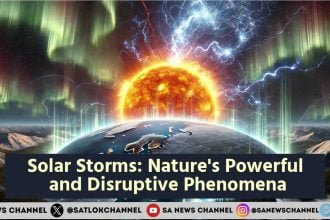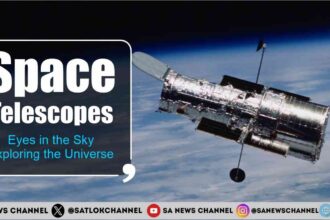The year 2025 has been packed with celestial wonders, from blood moon lunar eclipses to dazzling planetary alignments. Now, skywatchers are set for another astronomical highlight – the last solar eclipse of 2025, occurring on Sunday, September 21. This rare partial solar eclipse will be the second and final solar eclipse of the year, and although it will not be visible in India, it promises breathtaking views for observers in select regions of the Southern Hemisphere.
- Solar Eclipse 2025 Timings in IST
- Where Will the Eclipse Be Visible?
- What is a Partial Solar Eclipse?
- Next Solar Eclipses After 2025
- Scientific Significance of the 2025 Eclipse
- Safety Guidelines: How to Watch the Eclipse Without Harm
- Cultural and Traditional Context
- Final Word: A Celestial Farewell to 2025
- Spiritual Insights During Solar and Lunar Eclipses: Teachings of Saint Rampal Ji Maharaj Ji
- FAQs on Partial Solar Eclipse of September 21, 2025
Solar Eclipse 2025 Timings in IST
According to astronomical predictions, the eclipse will unfold over several hours. The official timings (in Indian Standard Time) are as follows:
- Start of Eclipse: 10:59 PM IST, September 21, 2025
- Maximum Eclipse: 1:11 AM IST, September 22, 2025
- End of Eclipse: 3:23 AM IST, September 22, 2025
While the timings are provided in IST, visibility will vary across the globe depending on location and time zones.
Where Will the Eclipse Be Visible?
This partial solar eclipse will be visible mainly from the Southern Hemisphere, covering oceanic regions and select landmasses. Areas expected to witness varying degrees of solar obscuration include:
- New Zealand: Best visibility, with up to 85% of the Sun obscured in the South Island. The eclipse here coincides with sunrise, producing a stunning ‘sunrise eclipse’ effect.
- Eastern Australia: Limited visibility in a narrow strip along the Queensland coast.
- Antarctica: High obscuration reaching nearly 80% in regions such as the Ross Sea. Weather conditions, however, may limit safe viewing.
- South Pacific Islands: Countries like Fiji, Tonga and Samoa will experience between 50–70% obscuration during the morning hours.
- Southern South America: Minimal visibility, under 10%, in southern Chile and Argentina, close to sunset.
In contrast, India, Asia, Europe, North America and most of Africa will not see the eclipse at all.
What is a Partial Solar Eclipse?
A solar eclipse occurs when the Moon passes between the Earth and the Sun, casting a shadow that either partially or completely blocks sunlight from reaching certain parts of the Earth. Among the various categories of solar eclipse, the most well-known and studied are:
- Total Solar Eclipse: The Moon completely covers the Sun, turning day into twilight for a short duration.
- Annular Solar Eclipse: The Moon appears smaller and does not cover the Sun entirely, creating a ‘ring of fire’ effect.
- Partial Solar Eclipse: The Moon covers only part of the Sun, giving the impression of a ‘bite’ being taken out of it, with a little part visible during the eclipse.
The September 21 event falls into the third category – partial solar eclipse, with no location experiencing a total blackout of the Sun.
Next Solar Eclipses After 2025
We are expected to witness more solar eclipses in the days to come, namely:
- February 17, 2026: A solar eclipse (not visible from India).
- August 12, 2026: A solar eclipse (again, not visible from India).
- August 2027: Date is to be confirmed. India will finally be able to witness a solar eclipse, making it a highly anticipated astronomical event.
Scientific Significance of the 2025 Eclipse
While eclipses often attract cultural and religious interpretations, their science has often been considered as important by the scientific community. It has been believed to aid the following studies:
- Orbital Mechanics: Observing the eclipse helps understand the Sun-Moon-Earth dynamics.
- Solar Studies: Eclipses allow astronomers to safely study solar features like sunspots and the outer atmosphere (corona).
- Educational Value: They serve as real-time examples for students and researchers studying astronomy.
Safety Guidelines: How to Watch the Eclipse Without Harm
Viewing a solar eclipse without protection can cause serious and permanent eye damage. Experts strongly advise following these safety measures:
- Never look directly at the Sun with the naked eye, binoculars, telescopes or cameras.
- Always watch such astronomical events with eclipse glasses or solar viewers (preferably, ISO 12312-2 certified).
- Equip telescopes and cameras with solar filters before aiming at the Sun.
- Try indirect viewing methods, such as a pinhole projector made with cardboard and foil.
- Even with filters, limit exposure time to reduce cumulative risk.
Cultural and Traditional Context
Although the September 21 eclipse will not be visible in India, its timing coincides with the final day of Pitru Paksha, a period in Hindu tradition dedicated to paying respect to ancestors. Traditionally, many people in India observe certain practices during eclipses, such as avoiding meals, staying indoors, and engaging in meditation or prayer.
Though these practices are rooted in cultural beliefs, they only coexist with scientific guidelines that emphasise safety and awareness. However, none of the Pitru Paksh rituals find any validation in our holy scriptures, rendering them as practices against the directives of our sacred texts.
To understand the unparalleled method of providing solace to departed souls of our ancestors, and the truth of existing practices of Shraddh, watch the following video:
Final Word: A Celestial Farewell to 2025
The partial solar eclipse of September 21, 2025, is more than just an astronomical event. It is a reminder of the intricate dance of celestial bodies directed by a higher Supreme Power, beyond scientific reasoning.
With up to 85% obscuration in regions like New Zealand and Antarctica, this eclipse offers a spectacular farewell to the year’s astronomical calendar. Though not visible in India, enthusiasts can experience it through live streams, photographs and scientific coverage. As the world prepares for future eclipses in 2026 and beyond, this event serves as a reminder how small scientific discoveries are in front of the Supreme Power Who governs all universes.
Spiritual Insights During Solar and Lunar Eclipses: Teachings of Saint Rampal Ji Maharaj Ji
In India, traditional beliefs around solar and lunar eclipses often include specific rituals, especially for pregnant women, such as applying vermillion (red powder) and restricting outdoor activities. Many follow these customs without knowing the true spiritual significance behind them, leading only to confusion and fear.
However, Tatvdarshi Saint Rampal Ji Maharaj Ji alone, has successfully dismantled these worldly fears through the authentic path of worship bestowed by Him. Once under the refuge of the sole Tatvdarshi Sant (Complete Saint) of this cosmos, events such as solar eclipses hold no power and effect on the disciple. Sant Rampal Ji Maharaj bestows the true worship of our Ultimate Creator Supreme God Kabir Sahib Ji. Ancient texts, including the Yajurveda and Rigveda, affirm that the Supreme God alone has the power to destroy even the most severe sins and relieve karmic burdens.
Saint Rampal Ji Maharaj Ji explains that devotion to Brahma, Vishnu and Mahesh cannot alleviate the suffering of the threefold karmas, but complete surrender to Supreme God Kabir Sahib through a Satguru’s guidance leads to the destruction of karmic bonds and attainment of true liberation (Moksha).
Kabir Saheb’s Vani says :
Hum kaun Raam Ka Japte Japam , Tatey Katey Naa Ye Teeno Tapam .
Following the spiritual guidance of a truly knowledgeable saint (Tatvdarshi Sant) ensures that worldly fears, such as those associated with eclipses, have no effect on one’s life.
This unique wisdom demonstrates that spiritual protection and ultimate liberation are achieved not through rituals or superstitions but through devotion to the Supreme God Kabir Sahib under the guidance of Saint Rampal Ji Maharaj Ji.
For authentic teachings and further spiritual guidance, visit www.jagatgururampalji.org.
FAQs on Partial Solar Eclipse of September 21, 2025
Q1. Will the September 21, 2025 solar eclipse be visible in India?
No. The partial solar eclipse on September 21, 2025 will not be visible in India or most parts of Asia, Europe, Africa and North America. It will mainly be visible from New Zealand, Antarctica, eastern Australia, South Pacific islands and parts of South America.
Q2. What time will the solar eclipse occur on September 21, 2025?
The eclipse will begin at 10:59 PM IST on September 21, reach its maximum at 1:11 AM IST on September 22, and end at 3:23 AM IST. Timings may vary based on the local region.
Q3. How much of the Sun will be covered during this eclipse?
The greatest obscuration will occur in New Zealand, where up to 85% of the Sun’s disk will be covered. Other regions like Antarctica will see nearly 80% coverage, while the Pacific islands will witness between 50–70%.
Q4. How can the September 2025 solar eclipse be observed safely?
It is dangerous to look at the Sun directly. Always use ISO-certified solar eclipse glasses, solar filters for telescopes/cameras, or indirect methods such as a pinhole projector. Never use the naked eye, sunglasses, or unprotected optical devices.
Q5. When will the next solar eclipse be visible in India?
India will not witness the September 21, 2025 eclipse. The next solar eclipses after this are in February and August 2026, but they will not be visible from India. However, a major solar eclipse will be visible in India in August 2027.









